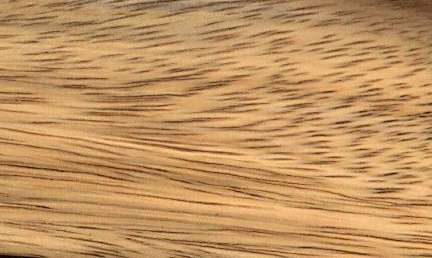
Guachapele (Pseudosamanea guachapele)
Family: Leguminosae
Common names: Cadeno, Frijolillo, Guachapele, Guachapeli, Guamarillo, Samanigua, Tabaca
Distributed in: Columbia, Ecuador, Guatemala, Honduras, Venezuela (Central America, Latin America)
Distribution overview: The species occurs from Guatemala in Central America, southward to Venezuela and Ecuador in South America. It is usually found growing on dry sites, and regenerates in abandoned fields and pastures.
Common uses: Boat building (general), Boat building, Boat building: decking, Boat building: framing, Boat building: planking, Building construction, Cabinetmaking, Construction, Crossties, Decorative veneer, Flooring, Flooring: industrial heavy traffic, Furniture , Furniture components, Furniture, Heavy construction, Joinery, Light construction, Mine timbers, Piling, Plywood, Railroad ties, Shipbuilding, Turnery, Vehicle parts, Veneer, Veneer: decorative
Environment profile: Status unknown due to inadequate data
Tree size: Trunk diameter is 200-250 cm
Colors: the heart isYellow brown upon drying , Yellow to golden-yellow to orangeand the sapwoodWhitish, Yellow.The grain isRoey figure, the textureMedium to very coarse and the lusterLustrous
Natural durability: Very durable, Very good weathering properties
Odor: No specific smell or taste
Kiln Schedules: Drying (speed) is fast
Drying Defects: Slight twist/warp, Splitting
Ease of Drying: Reconditioning Treatement
Tree Identification: Bole/stem form is not buttressed
Comments: General finishing qualities are rated as good
Boring: Poor to very poor results
Carving: Fairly Easy to Very Easy
Cutting Resistance: Easy to saw
Gluing: Easy to glue
Mortising: Poor to Very Poor
Moulding: Poor to Very Poor
Movement in Service: Poor to Very Poor
Planing: Surfaces tend to be woolly
Resistance to Impregnation: Resistant sapwood
Response to hand tools: Easy to machine
Routing recessing: Poor to Very Poor Results
Sanding: Good sanding finish
Veneering qualities: Suitable for slicing
Steam bending: Fair to Good Results
Turning: Poor to Very Poor Results
Polishing: Fair to Good; Varnishing: Fair to Good;
- Numerical data Metric
- Numerical data English
- Strength properties
- References
 |
 |
 |
 |
| Item |
Green |
Dry |
Metric |
| Specific Gravity |
0,54 |
0,58 |
|
| Density |
|
641 |
kg/m3 |
| Bending Strength |
539 |
772 |
kg/cm2 |
| Crushing Strength |
278 |
460 |
kg/cm2 |
| Hardness |
|
465 |
kg |
| Impact Strength |
|
|
cm |
| Shearing Strength |
|
|
kg/cm2 |
| Stiffness |
82 |
87 |
1000 kg/cm2 |
| Tangential Shrinkage |
4 |
|
% |
| Radial Shrinkage |
2 |
|
% |
| Weight |
624 |
496 |
kg/m3 |
| Maximum Load |
0,35 |
0,49 |
cm-kg/cm3 |
| Toughness |
|
146 |
cm-kg |
| Static Bending |
|
|
kg/cm2 |
|
 |  |  |  | | Item | Green | Dry | English | | Bending Strength | 7679 | 10993 | psi | | Density | | 40 | lbs/ft3 | | Hardness | | 1027 | lbs | | Maximum Crushing Strength | 3963 | 6549 | psi | | Stiffness | 1168 | 1240 | 1000 psi | | Toughness | | 127 | inch-lbs | | Work to Maximum Load | 5 | 7 | inch-lbs/in3 | | Specific Gravity | 0.54 | 0.58 | | | Weight | 39 | 31 | lbs/ft3 | | Radial Shrinkage | 2 | | % | | Tangential Shrinkage | 4 | | % | | Volumetric Shrinkage | 8 | | % | |
Modulus of Elasticity (stiffness) = very low
Bending strength (MOR) = low
Shrinkage, Tangential = very small
Shrinkage, Radial = very small
Work to Maximum Load = very low
Density (dry weight) = 38-45 lbs/cu. ft.
Bending strength (MOR) = medium
Modulus of Elasticity (stiffness) = low
Hardness (side grain) = soft
Shrinkage, Tangential = small
Resists denting and marring
Heavy
Density = high
Density (dry weight) = 46-52 lbs/cu. ft.
Density (dry weight) = 31-37 lbs/cu. ft.
Compression strength (parallel to grain) = high
Hardness (side grain) = medium
Berni, C.A., Bolza, E., Christensen, F.J.,1979,South American Timbers - The Characteristics, Properties and Uses of 190,Species,C.S.I.R.O Div. Building ResearchChudnoff, M.,1984,Tropical Timbers of the World,U.S.A. Department of Agriculture, Forest Service, Forest Products,Laboratory, Madison.Demougeot, M.,1968,Finishing of Exotic Timbers containing aliphatic and resinous substances,in the Furniture Industry,Drevo,23(7,pp248-52Dickinson, F.E.,1949,Properties and Uses of Tropical Woods 1,Tropical Woods,13(95,pp1-140Kribbs, D.A. 1959. Commercial Foreign Woods on the American Market. Buckhout Lab., Dept. of Botany, The Pennsylvania State University, University Park, Pennsylvania.Little, E.L.,1948,A Collection of Tree Specimens from Western Ecuador,Caribbean Forester,9(3,pp215-98Timber Development Association Ltd.,1948,Notes on Ecuadorian Timbers,TRADA, Timber Information,35,pp5Wangaard, F.F., Muschler, A.F.,1952,Properties and Uses of Tropical Woods 3,Tropical Woods,14(98, pp1-190WCMC. 1992. Conservation Status Listing: Trees and Timbers of the World. World Conservation Monitoring Center (WCMC, Plants Program, 219 Huntingdon Road, Cambridge, CB3 ODL, United Kingdom.
|








